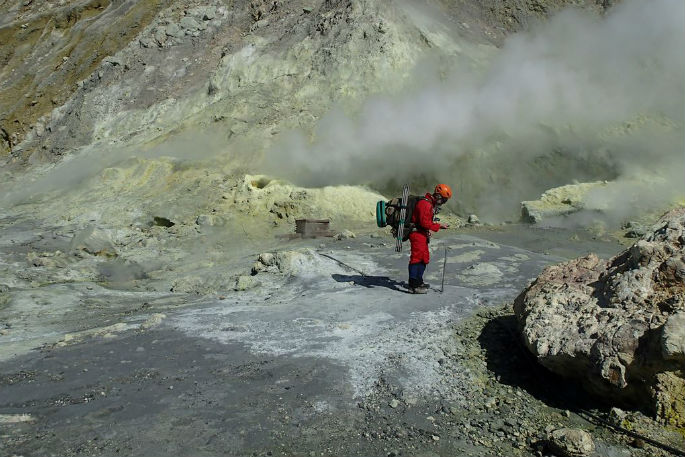Access to the active crater area on White Island has now become available to scientists, for the first time since late 2015.
Declining activity on the volcano has allowed scientists to take samples from the Crater Lake alongside gas from active vents.
GeoNet Volcano Information Specialist, Brad Scott says several trips were made to the volcano in the last few weeks, where new samples were able to be collected and crucial maintenance was carried out.
'For the first time ever we have been able to sample energetic fumaroles inside the crater, including those on the lava dome that grew during the 2012 eruptions.
'We have also completed our repairs to the solar arrays damaged by the cyclones last autumn, and made a deformation survey.”
Last year on April 27, an explosive eruption occurred from the active crater area. The eruption threw out the Crater Lake and excavated the lake floor by approximately 13m.
The blast, generated by the eruption, travelled across the Main Crater floor and buried vital survey pegs and markers. Tourist trails on the island were also obscured by eruption deposits.
Mild ash eruptions also followed in September.
Over the past year, water has been sitting in sunken ponds and small craters in parts of its floor, and only since April this year has there been a stable lake, says Bradley.
'While we are now comfortable to call this a ‘new' crater lake, it is quite different from past lakes.
'The most noticeable difference is the temperature, which last week was only 20˚c; in the past, a temperature of 30-70˚c has been typical.”
Chemical analyses of a sample collected in late July, shows some of the lowest concentration levels recorded in the lake water, in over 15 years.
'This is because there are few volcanic gases and liquids entering the lake; this lake is mostly formed by rainfall and run-off.
'While the lake is now very ‘dilute', it is still as acidic as battery acid, so you wouldn't want to drink it or swim in it,” says Brad.
In November-December 2012, a lava extrusion occurred on the active crater floor that created a small lava ‘dome'.
Thermal infra-red measurements at that time indicated gases escaping the fumaroles had a temperature more than 450˚C.
Following last year's eruptions, the temperature had declined to 330˚C and has continued to decline this year.
'It is now only 114˚C, although the gas flux remains moderate and vigorous. Due to the declining activity we have been able to access and sample these.
'Fumarole ‘0', a very accessible high temperature gas vent, and one that many tourists to the island visit, is also declining in temperature and is now only 152˚C down from highs over 190˚C in late 2016,” says Brad.
'We have also re-established our survey networks damaged or destroyed by the April 2016 eruption and are now establishing trends in those data.”
Recent observations and measurements indicate the level of volcanic unrest is declining.
'This reduction in activity is creating a new opportunity for us to collect data that we couldn't before, especially about the gases in the active crater.
'These data, along with our more traditional data, confirm volcanic unrest is still present and Whakaari remains an active volcano.”



1 comment
More likely
Posted on 24-08-2017 13:35 | By MISS ADVENTURE
That the cork in the hole is tighter than before, so less gas, heat and activity for now. The game is still raging below, that much is unchanged.
Leave a Comment
You must be logged in to make a comment.